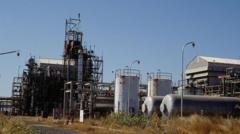After 40 years of stagnant progress, Indian authorities have removed toxic waste from the infamous Bhopal gas leak site, but health risks from past negligence linger as activists raise alarms over potential dangers at the new disposal location.
Toxic Waste Removal from Bhopal Gas Leak Site Marks Major Step After Four Decades

Toxic Waste Removal from Bhopal Gas Leak Site Marks Major Step After Four Decades
Authorities successfully transfer hazardous materials from Union Carbide plant, prompting health concerns among local activists.
In a historic move, authorities in India have finally removed hundreds of tonnes of toxic waste from the Union Carbide plant in Bhopal, a site infamous for one of the deadliest industrial disasters in history. The tragic gas leak occurred in December 1984, resulting in the immediate deaths of thousands and long-term health effects for many more. On Wednesday, officials transported approximately 337 tonnes of hazardous waste to a specialized incineration facility located about 230 kilometers away, following a court order issued last month mandating the disposal within four weeks.
The removal process commenced on Sunday, culminating in a secure transfer carried out under strict safety measures including police escorts and emergency services. This waste, which consists of various dangerous materials including pesticide residue categorized as "forever chemicals," has been a looming environmental threat, contaminating groundwater for surrounding communities for decades.
Despite the removal being a notable milestone, activists remain skeptical. Concerns are particularly pronounced around the new location designated for disposal; prior mishandlings of similar waste have led to significant pollution in nearby regions. A recent assessment revealed that groundwater across 42 residential areas has been tainted by toxic compounds from the site, highlighting the enduring impact of the leak.
Local activist groups argue that the situation resembles a "slow-motion Bhopal," wherein the health hazards of toxic waste are merely shifted rather than resolved. Rachna Dhingra from the International Campaign for Justice in Bhopal emphasized that the transported waste constitutes only a fraction of the overall contamination, amounting to 1.1 million tonnes still polluting the local resources.
History bears witness to challenges faced in the disposal solutions for this waste, with previous plans thwarted by protests in various states including Gujarat and Hyderabad. The Bhopal gas tragedy remains a case study in industrial negligence, with thousands still suffering from its aftermath. Despite a compensation settlement offered by Union Carbide in the past, many families claim justice remains unfulfilled, further complicating efforts for true remediation and accountability moving forward.





















